
The Avro Shackleton is a British long-range maritime patrol aircraft (MPA) which was used by the Royal Air Force (RAF) and the South African Air Force (SAAF). It was developed by Avro from the Avro Lincoln bomber, which itself had been a development of the famous wartime Avro Lancaster bomber.
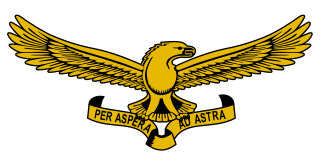
The South African Air Force (SAAF) is the air warfare branch of South African National Defence Force, with its headquarters in Pretoria. The South African Air Force was established on 1 February 1920. The Air Force saw service in World War II and the Korean War. From 1966, the SAAF was involved in providing infantry support in the low-intensity Border War in Angola, South-West Africa and Rhodesia. As the war progressed, the intensity of air operations increased, until in the late 1980s when the SAAF were compelled to fly fighter missions against Angolan aircraft in order to maintain tactical air superiority. On conclusion of the Border War in 1990, aircraft numbers were severely reduced due to economic pressures as well as the cessation of hostilities with neighbouring states.

2 Squadron is a squadron in the South African Air Force which was formed in 1940. The squadron has a long history, having been involved in every single combat action in which the SAAF has taken part. During the Second World War it made a name for itself in the battles for East Africa, before distinguishing itself in North Africa as part of the Desert Air Force, and later in Italy.
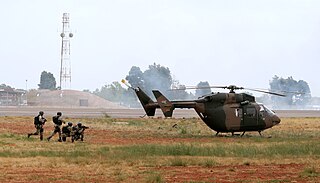
15 Squadron SAAF is a squadron of the South African Air Force. It is currently a transport/utility helicopter squadron.

41 Squadron is a light transport squadron of the South African Air Force. It was formed in 1940, it is currently based at AFB Waterkloof.
Canadian Forces Base Summerside was an air force base located in St. Eleanors, Prince Edward Island, Canada, now part of the city of Summerside.

Darling is a small town in a farming area on the west coast region of the Western Cape, about 75 km (46.6 mi) from Cape Town.
The South African Air Force Museum houses exhibits and restores material related to the history of the South African Air Force. The museum is divided into three locations, AFB Swartkop outside Pretoria, AFB Ysterplaat in Cape Town and at the Port Elizabeth airport.
Wingfield Aerodrome was first the Cape Town Municipal Aerodrome, then Air Force Station Wingfield under the SAAF, before being used as a Fleet Air Arm base by the Royal Navy. After World War II, the aerodrome reverted to being the municipal airport for a while. The history of Wingfield is synonymous with the history of flight in South Africa, including pioneering attempts at commercial aviation.

4 Squadron SAAF was a South African Air Force unit which served during World War II.

7 Squadron was a unit of the South African Air Force which served in the Second World War as well as in South Africa between 1951 and 1992. During the war, the squadron was used as a fighter squadron deployed to the Western Desert as well as in the Aegean, Italy and Ceylon. The squadron was inactive from the end of the war until 1951 when it re-activated as a citizen force training squadron, a role it retained during two periods of active service until 1992, when it was disbanded for the last time.

10 Squadron was a squadron of the South African Air Force. It was formed as a fighter bomber unit on 1 April 1939 and was deployed in a coastal defence role as part of Coastal Command SAAF until 1943. It was disbanded after the threat of Japanese naval actions off the South African coast had waned. It was re-activated as a fighter squadron on 25 May 1944 and deployed to the Middle East where the squadron saw service in Syria, Libya and the Aegean and was disbanded at the end of the war in Italy.
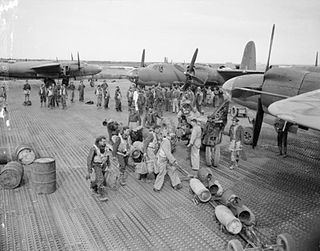
25 Squadron was a maritime patrol and later medium bomber squadron of the South African Air Force during World War II. It was re-constituted twice between 1951 and 1990 as a medium transport squadron and was finally disbanded in October 1990.
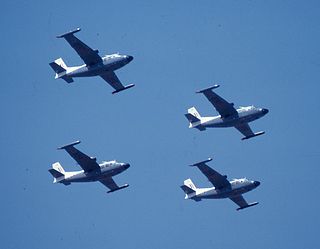
27 Squadron was established as a World War II maritime patrol squadron of the South African Air Force. It was disbanded after the war and resurrected in the same role from 1951 to 1958. Its final period of service was from 1962 to 1990 when it was finally disbanded when its Piaggio Albatross aircraft were de-commissioned.
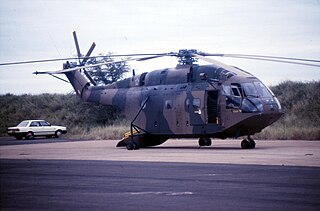
30 Squadron SAAF was a squadron of the South African Air Force. It was established in 1944 and saw service as a medium bomber squadron in Italy during the Second World War. After the war, the squadron was disbanded and was resurrected in 1980 as a medium transport helicopter squadron – a role it retained until it was finally disbanded in 1991.
The History of the South African Air Force spans the First World War, Rand Rebellion of 1922, the Second World War, the Korean War, the South African Border War, and varied peacekeeping operations since 1994. Its battle honours include German South West Africa 1914–15, German East Africa 1915–1918, East Africa: 1939–1941, Middle East: 1941–43, Madagascar 1942, Italy 1943–1945, the Balkans 1943–1945, and Korea 1950–1953.
Southern Air Command was a formation of the South African Air Force, active from the early 1980s to the early 1990s. Throughout its existence, it had its headquarters at Silvermine, in the Cape Province.

16 Squadron SAAF is an attack helicopter squadron of the South African Air Force (SAAF). It was originally formed in World War II as a maritime patrol squadron, however, over the course of the war it was disbanded and reformed a number of times, operating a number of different types of aircraft. It was finally disbanded in June 1945 and was not re-raised until 1968 as a helicopter squadron. In the late 1980s the squadron took part in the conflict in Angola before being disbanded again in 1990. It was raised once more in 1999 and it is currently operating the Rooivalk attack helicopter.
Ysterplaat is a northern suburb of Cape Town, South Africa, around 10 km west-northwest of City Hall. It borders Paarden Eiland to the southwest, Brooklyn and Rugby to the west, Kensington to the south, and Century City to the northeast.













